On my Jotul Oslo V2, I don't start to turn the air intake down until after it reaches 400 degrees. If I am burning under seasoned wood it will likely not reach 400 degrees. With good wood it will reach 400 degrees easily and then I can turn it down for a nice secondary burn. If I start turning the air down prior to 400 I find that I run the chance of the fire smoldering.
Jotul F55 1 hour burn time Help!
- Thread starter Trunkinator
- Start date
-
Active since 1995, Hearth.com is THE place on the internet for free information and advice about wood stoves, pellet stoves and other energy saving equipment.
We strive to provide opinions, articles, discussions and history related to Hearth Products and in a more general sense, energy issues.
We promote the EFFICIENT, RESPONSIBLE, CLEAN and SAFE use of all fuels, whether renewable or fossil.
You are using an out of date browser. It may not display this or other websites correctly.
You should upgrade or use an alternative browser.
You should upgrade or use an alternative browser.
Are you talking 400 stovetop or 400 flue temp?On my Jotul Oslo V2, I don't start to turn the air intake down until after it reaches 400 degrees. If I am burning under seasoned wood it will likely not reach 400 degrees. With good wood it will reach 400 degrees easily and then I can turn it down for a nice secondary burn. If I start turning the air down prior to 400 I find that I run the chance of the fire smoldering.
Caw
Minister of Fire
It sounds to me like, as you said, you are simply babying the stove. It's good to be cautious at first but keep in mind it's designed to run much harder than you are pushing it.
Just for some perspective here is my set up and how I run it. I'm relatively new too and it took me some time to get a good rhythm:
Stove - Osburn 1600 insert. 1.85 cu ft. This is the only heat source we use all winter.
Chimney - 24' exterior masonry w/liner
House - 1600 sq ft 2 story cape style
Wood - Maple, cherry, ash all 16-18%. Also some oak around 20-22% and some bone dry poplar trash for shoulder season. I have to load E/W due to my firebox size.
Cold start - Top down. Two tiny pieces of kindling N/S below the wood to make a little room for air. It really helps get it going faster. I make a little cradle for the kindling so I can add a split once it takes off. I have a magnetic condor infernk stove top thermometer which is actually decent, way better than the rutland imo, but I mainly use my IR gun to zap the pipe/stove junction for a more real time reading. I let it rip door cracked, eventually add a split to the kindling pile, door shut, let it roll until im getting 400-450 usually. Ill crank it down in 2-3 steps with the final step being around 600-650 degrees and mostly of not fully closed. Blower goes on here...I usually only run it in low unless I want to lower the temps. High steals a lot of heat from the box. The stove will cruise around there for a good 1-2 hours depending on how much wood I managed to cram in there. After the crazy off gassing phase ill open the air to about 10% and cruise on home...no need to touch the air until its almost reload time.. STT usually around 550 ish here and slowly works down. It'll live in the 400-450 give or take range for a few hours. If I want active heat a full load will get me around 5-6 hours usually. There are still enough coals that I can still reload at the 7-8 hour mark just the STT will be 250-300 and not putting out much heat.
Reloading - I like to reloading around 300 STT. Before reloading I'll open the air up and smack around the coals to break up anything big then give it 5 mins to heat up. Then I'll rake the coals forward, same E/W load. Smaller splits on the bottom and big boys in the middle. I like to tetris as much as I can in there. I like to get a good small dry piece right in the coals to aid ignition. After that its the same as a cold start only itll happen much faster and I can get more wood in it.
I think you'll notice two main things relative to your stove/practice: my box is smaller and I am hitting much higher temps. This is due to the fact that I am stuffing it chock full of wood. Sure its easier with drier wood but 20-22%, while not ideal, is plenty good enough itll just need a a bit more air and not be as efficient. 650 might sound really hot but in reality it's not. My stove isn't considered to be in over-fire until about 850 degrees so im really well below the limit. EPA tube stoves are designed to run hot to reach their potential. Each stove will have a temp it likes to cruise at depending on wood, draft, weather etc...but if its a tube stove it's likely wanting 500+ during off gassing.
Anyways just thought my practice might help you along. I was very afraid of pushing too hard early too but I learned through research here and experimenting with more and more wood that the stove works best when it's run harder versus softer. It's doable to work it hard and stay safe once you get the hang of it.
Also, if during your experimenting you feel it's getting out of control you can always open the door. Sounds strange but it'll shut down the secondary combustion and cool things down. Just don't walk away!
Just for some perspective here is my set up and how I run it. I'm relatively new too and it took me some time to get a good rhythm:
Stove - Osburn 1600 insert. 1.85 cu ft. This is the only heat source we use all winter.
Chimney - 24' exterior masonry w/liner
House - 1600 sq ft 2 story cape style
Wood - Maple, cherry, ash all 16-18%. Also some oak around 20-22% and some bone dry poplar trash for shoulder season. I have to load E/W due to my firebox size.
Cold start - Top down. Two tiny pieces of kindling N/S below the wood to make a little room for air. It really helps get it going faster. I make a little cradle for the kindling so I can add a split once it takes off. I have a magnetic condor infernk stove top thermometer which is actually decent, way better than the rutland imo, but I mainly use my IR gun to zap the pipe/stove junction for a more real time reading. I let it rip door cracked, eventually add a split to the kindling pile, door shut, let it roll until im getting 400-450 usually. Ill crank it down in 2-3 steps with the final step being around 600-650 degrees and mostly of not fully closed. Blower goes on here...I usually only run it in low unless I want to lower the temps. High steals a lot of heat from the box. The stove will cruise around there for a good 1-2 hours depending on how much wood I managed to cram in there. After the crazy off gassing phase ill open the air to about 10% and cruise on home...no need to touch the air until its almost reload time.. STT usually around 550 ish here and slowly works down. It'll live in the 400-450 give or take range for a few hours. If I want active heat a full load will get me around 5-6 hours usually. There are still enough coals that I can still reload at the 7-8 hour mark just the STT will be 250-300 and not putting out much heat.
Reloading - I like to reloading around 300 STT. Before reloading I'll open the air up and smack around the coals to break up anything big then give it 5 mins to heat up. Then I'll rake the coals forward, same E/W load. Smaller splits on the bottom and big boys in the middle. I like to tetris as much as I can in there. I like to get a good small dry piece right in the coals to aid ignition. After that its the same as a cold start only itll happen much faster and I can get more wood in it.
I think you'll notice two main things relative to your stove/practice: my box is smaller and I am hitting much higher temps. This is due to the fact that I am stuffing it chock full of wood. Sure its easier with drier wood but 20-22%, while not ideal, is plenty good enough itll just need a a bit more air and not be as efficient. 650 might sound really hot but in reality it's not. My stove isn't considered to be in over-fire until about 850 degrees so im really well below the limit. EPA tube stoves are designed to run hot to reach their potential. Each stove will have a temp it likes to cruise at depending on wood, draft, weather etc...but if its a tube stove it's likely wanting 500+ during off gassing.
Anyways just thought my practice might help you along. I was very afraid of pushing too hard early too but I learned through research here and experimenting with more and more wood that the stove works best when it's run harder versus softer. It's doable to work it hard and stay safe once you get the hang of it.
Also, if during your experimenting you feel it's getting out of control you can always open the door. Sounds strange but it'll shut down the secondary combustion and cool things down. Just don't walk away!
Love the idea of the aluminum foil. I didn't even think about the section occurring that would certainly work in my favor. Next time I'm out I'm going to stop by a store and see if i can see another stove off my model and compare the air control. I'm assuming it's normal, i spoke with a couple other people that had different
Matt
Wow, Caw. I very much appreciate your feedback. Now that sounds like a realistic, good plan when i compare your experience with mine. I never tried raking all coals forward, i can really see how that would slow the burn. I think i made the mistake, of just spreading out the hot coals and at 250-300 sst putting in another stack of splits N/S, not E/W. In the back of my mind i keep saying to myself it's fine, fill it up and burn it, but again, being new and hesitant, i felt like i was literally looking into the depths of hell when i filled it two-thirds full, and it peaked at 550 if i recall correctly. I have a condar SST and a Condar single wall flue temp thermo in the Mail, set to arrive this week. I've also finally got in contact with the guy who installed my stove, and he's going to come out and give me some assistance and also test my draft. I'm not sure if you saw another post i did, but literally everyone i talked to, literally everyone, in the months leading up to buying a stove, said you won't want it in the basement, you'll get bad back draft and it simply won't work. I went with my gut, even though i truly knew nothing at the time, but that was the only place it could go. Plus, there was already a full surround, hearth, and monster smoke dragon installed from 1963 when the home was built. So i said screw it, if it doesn't work, i cross that bridge when i come to it. This thing, honestly, is like a vacuum cleaner. I pop the door open all the way while i prep my wood, etc. this lets house air into the flue. Within a couple minutes of being open, i have my wood stacked up and kindling placed for a top-down fire. I light a super dried frilly piece of small ash, i have a trash bin full of small frilly kindling, and immediately the smoke rises and i have a positive draft. When the fire is roaring, it almost sounds like rushing water. Not sizzling, but that low strong rushing of air and with the air control all the way down, it's still got pretty heavy flame coming from splits, with portal-to-hell swirling around up top. I'm very interested to have the draft tested. Thanks again for your reply, I'll be sure to update within the coming weeks as i learn more about my stove situation.It sounds to me like, as you said, you are simply babying the stove. It's good to be cautious at first but keep in mind it's designed to run much harder than you are pushing it.
Just for some perspective here is my set up and how I run it. I'm relatively new too and it took me some time to get a good rhythm:
Stove - Osburn 1600 insert. 1.85 cu ft. This is the only heat source we use all winter.
Chimney - 24' exterior masonry w/liner
House - 1600 sq ft 2 story cape style
Wood - Maple, cherry, ash all 16-18%. Also some oak around 20-22% and some bone dry poplar trash for shoulder season. I have to load E/W due to my firebox size.
Cold start - Top down. Two tiny pieces of kindling N/S below the wood to make a little room for air. It really helps get it going faster. I make a little cradle for the kindling so I can add a split once it takes off. I have a magnetic condor infernk stove top thermometer which is actually decent, way better than the rutland imo, but I mainly use my IR gun to zap the pipe/stove junction for a more real time reading. I let it rip door cracked, eventually add a split to the kindling pile, door shut, let it roll until im getting 400-450 usually. Ill crank it down in 2-3 steps with the final step being around 600-650 degrees and mostly of not fully closed. Blower goes on here...I usually only run it in low unless I want to lower the temps. High steals a lot of heat from the box. The stove will cruise around there for a good 1-2 hours depending on how much wood I managed to cram in there. After the crazy off gassing phase ill open the air to about 10% and cruise on home...no need to touch the air until its almost reload time.. STT usually around 550 ish here and slowly works down. It'll live in the 400-450 give or take range for a few hours. If I want active heat a full load will get me around 5-6 hours usually. There are still enough coals that I can still reload at the 7-8 hour mark just the STT will be 250-300 and not putting out much heat.
Reloading - I like to reloading around 300 STT. Before reloading I'll open the air up and smack around the coals to break up anything big then give it 5 mins to heat up. Then I'll rake the coals forward, same E/W load. Smaller splits on the bottom and big boys in the middle. I like to tetris as much as I can in there. I like to get a good small dry piece right in the coals to aid ignition. After that its the same as a cold start only itll happen much faster and I can get more wood in it.
I think you'll notice two main things relative to your stove/practice: my box is smaller and I am hitting much higher temps. This is due to the fact that I am stuffing it chock full of wood. Sure its easier with drier wood but 20-22%, while not ideal, is plenty good enough itll just need a a bit more air and not be as efficient. 650 might sound really hot but in reality it's not. My stove isn't considered to be in over-fire until about 850 degrees so im really well below the limit. EPA tube stoves are designed to run hot to reach their potential. Each stove will have a temp it likes to cruise at depending on wood, draft, weather etc...but if its a tube stove it's likely wanting 500+ during off gassing.
Anyways just thought my practice might help you along. I was very afraid of pushing too hard early too but I learned through research here and experimenting with more and more wood that the stove works best when it's run harder versus softer. It's doable to work it hard and stay safe once you get the hang of it.
Also, if during your experimenting you feel it's getting out of control you can always open the door. Sounds strange but it'll shut down the secondary combustion and cool things down. Just don't walk away!
Matt
Caw
Minister of Fire
Happy to help and best of luck. Looking forward to reading about your progress!
Raking the coals forward will really help your burn times. Make the fire work to get to that fuel in the back... you'll get plenty of heat along the way. It'll also allow you to fit more wood in the box! Tetris that wood in there tightly.
Edit - If you do a N/S load you'll rake to the side. The coals should be parallel to your splits.
Raking the coals forward will really help your burn times. Make the fire work to get to that fuel in the back... you'll get plenty of heat along the way. It'll also allow you to fit more wood in the box! Tetris that wood in there tightly.
Edit - If you do a N/S load you'll rake to the side. The coals should be parallel to your splits.
Caw
Minister of Fire
Just to put some visuals to what I was saying I took a couple pics halfway thru my am burn:
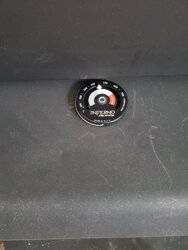
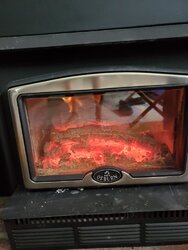
This is after about 3 hours in. First hour or so after everything fully caught it was mega off gassing it ran around 650 with the air mostly closed and blower on medium. Next hour the secondaries settled in, air to 10% open, blower on low, and it cruised around 550. It lived there for a while and slowly started working down to where we are now. I'll reload in 2-3 hours depending on the temps in the house and weather forecast etc. This load was stuffed full of smaller pieces of oak and ash. I save my big boy splits for overnight.
Edit - more pics 2 hours later...about 5 hours since ignition:
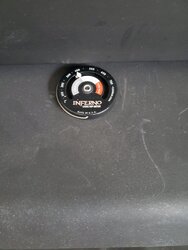
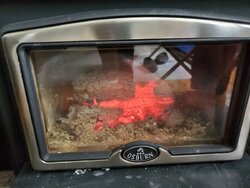
The stove just dipped below 400. Looking at my temps its about 71 inside (76 stove room) and a seasonable 32 outside. I dont need any more heat for a bit so im shutting off the blower and closing the air all the way. Since its only coals this won't damage the chimney and it will keep the box hot for a while longer. I'll probably reload a small-medium load in another 2 hours and just keep it minimally going until tonight.


This is after about 3 hours in. First hour or so after everything fully caught it was mega off gassing it ran around 650 with the air mostly closed and blower on medium. Next hour the secondaries settled in, air to 10% open, blower on low, and it cruised around 550. It lived there for a while and slowly started working down to where we are now. I'll reload in 2-3 hours depending on the temps in the house and weather forecast etc. This load was stuffed full of smaller pieces of oak and ash. I save my big boy splits for overnight.
Edit - more pics 2 hours later...about 5 hours since ignition:


The stove just dipped below 400. Looking at my temps its about 71 inside (76 stove room) and a seasonable 32 outside. I dont need any more heat for a bit so im shutting off the blower and closing the air all the way. Since its only coals this won't damage the chimney and it will keep the box hot for a while longer. I'll probably reload a small-medium load in another 2 hours and just keep it minimally going until tonight.
Last edited:
Sorry for leaving that out. Stovetop corner.Are you talking 400 stovetop or 400 flue temp?
Stovetop temp responds too slowly on a cold startup to be that useful, particularly when the draft is strong. It takes time to heat up the mass of a cast-iron stove. Our Castine could be in full secondary combustion at 250º stovetop. Flue temp is a more accurate guide.Sorry for leaving that out. Stovetop corner.
Sounds logical, but with both my Jotuls the stovetop has worked well and has been consistent for me. My prior had very strong draft and my current setup is more typical. 400 has been the magic number for confident light off of the secondaries.Stovetop temp responds too slowly on a cold startup to be that useful, particularly when the draft is strong. It takes time to heat up the mass of a cast-iron stove. Our Castine could be in full secondary combustion at 250º stovetop. Flue temp is a more accurate guide.
MR. GLO
Feeling the Heat
Close door, air control total open for 10 min more -- I think this part should be 500 stove top temp then close the air intake to less than half way or more. Wood really needs to be covered for two or three years to get best burn.Thanks for your insight! About an hour and i half ago or so, i raised the temp of my cold fire box to about 300 deg using some kiln dried birch splits. Once it was only hot coals and 250-275 deg, i did the following;
Started with 3 birch for embers, got hot coal bed and stove top therm at 200 deg(again this thermometer is not being friendly, I'm sure it was warmer than 200)
Put on 2 large 20% moisture ash and one medium 15% ash in middle, N/S big little big
Left Door cracked open 5 min until all splits are ablaze
Close door, air control total open for 10 min more. Stove top thermometer SLOOOOWLY climbing.... 250 now
Close air control halfway. Once flames visually settle down, close to a 1/4 open
Totally died at 20 min. opened control all the way, fire caught after a couple min,
At 28min, closed control halfway
At 43 min, close air control to 1/4, smaller lazy licking clear/blue orange tipped flames from all splits, splits are certainly charred
At 49 min fire died out. I opened the air control all the way in order to reignite the splits, with it did very quickly, and then i turned back to half throttle and been cruising since. At an hour in, still have three 70% intact splits. Temp reads 300 which has got to be BS. (I really don't like this Rutland thermometer - I'm calling it my yesterday's news thermometer )
It definitely seems like this stove will not maintain a fire with the air control closed, unless maybe i must get it up to 450-550deg so the secondaries ignite, then close it. I definitely couldn't get 400+ with 3 large splits, after this i will try with 5 good sized splits that are a bit dryer i guess.
I really need a good reliable thermometer. Any suggestions?
stove top is cast iron
Flue goes up 4ft from stove top, then 90 deg into wall.
no damper
Single wall pipe (inside the wall and chimney is all double wall)
thanks!!
MR. GLO
Feeling the Heat
When you go to 10 percent do you get any smoke out of your chimney? I am struggling...little less than 1/2 with air control equals no smoke but if i go to 10 percent it will smoke outside .Just to put some visuals to what I was saying I took a couple pics halfway thru my am burn:
View attachment 271323View attachment 271324
This is after about 3 hours in. First hour or so after everything fully caught it was mega off gassing it ran around 650 with the air mostly closed and blower on medium. Next hour the secondaries settled in, air to 10% open, blower on low, and it cruised around 550. It lived there for a while and slowly started working down to where we are now. I'll reload in 2-3 hours depending on the temps in the house and weather forecast etc. This load was stuffed full of smaller pieces of oak and ash. I save my big boy splits for overnight.
Edit - more pics 2 hours later...about 5 hours since ignition:
View attachment 271329View attachment 271330
The stove just dipped below 400. Looking at my temps its about 71 inside (76 stove room) and a seasonable 32 outside. I dont need any more heat for a bit so im shutting off the blower and closing the air all the way. Since its only coals this won't damage the chimney and it will keep the box hot for a while longer. I'll probably reload a small-medium load in another 2 hours and just keep it minimally going until tonight.
jzinckgra
Feeling the Heat
I've been burning our F55 for nearly 10yrs and somewhat embarrassingly, I still can't seem to get it to run consistent. Similar to others here, I have a hard time getting stove top up to 400-500F on ititial light. Typically, I'll get the initial fire up to 350F then start to close her down. The flue temp at that point is usually ~1000F. If I were to target a stopetop temp of 500-600, my flu temp would probably be over 1200F. Is that safe? I also notice that more often then not, my flu temp is more than 100F higher than stovetop regardless if it's the initial burn or a reload. Just this morning I threw in 3 pieces on a small bed of coals and once I got it going the stovetop temp was 350F, but flu temp was 600F. Air lever about 1/3 open. If I close it up, fire would die. We have double wall pipe (8') on the inside with a slight jog around the ceiling joist before exiting. Outside stack is 18'. Seems like we almost have too much draft, but not sure. We usually burn mostly oak with a little bit of pine, maple and ash. At times I really like the stove and it seems to behave well, but a lot of time is frustrating trying to get it to not lose the flame or get any secondary combustion. I understand there are a lot of variables, but would like to getter better performance. I'm sure it's the user, lol
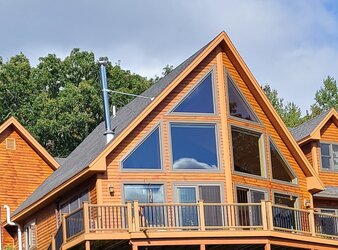
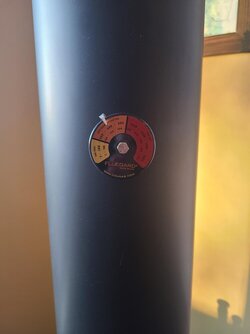
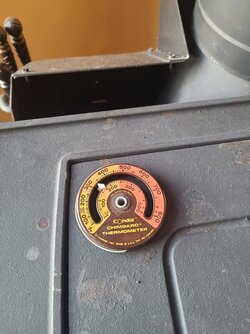
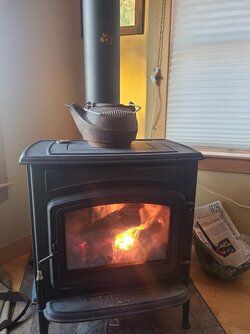




EbS-P
Minister of Fire
What is the total chimney height??I've been burning our F55 for nearly 10yrs and somewhat embarrassingly, I still can't seem to get it to run consistent. Similar to others here, I have a hard time getting stove top up to 400-500F on ititial light. Typically, I'll get the initial fire up to 350F then start to close her down. The flue temp at that point is usually ~1000F. If I were to target a stopetop temp of 500-600, my flu temp would probably be over 1200F. Is that safe? I also notice that more often then not, my flu temp is more than 100F higher than stovetop regardless if it's the initial burn or a reload. Just this morning I threw in 3 pieces on a small bed of coals and once I got it going the stovetop temp was 350F, but flu temp was 600F. Air lever about 1/3 open. If I close it up, fire would die. We have double wall pipe (8') on the inside with a slight jog around the ceiling joist before exiting. Outside stack is 18'. Seems like we almost have too much draft, but not sure. We usually burn mostly oak with a little bit of pine, maple and ash. At times I really like the stove and it seems to behave well, but a lot of time is frustrating trying to get it to not lose the flame or get any secondary combustion. I understand there are a lot of variables, but would like to getter better performance. I'm sure it's the user, lol
View attachment 319758 View attachment 319759 View attachment 319760 View attachment 319761
jzinckgra
Feeling the Heat
EbS-P
Minister of Fire
You probably need a pipe damper. High flue temps and lower stove top temps are my clues.~24'
jzinckgra
Feeling the Heat
that's what I was starting to think, but won't that cause greater creosote buildup? How difficult is it to install a damper? Actually I think our total stack is closer to 20', as we only have 2x8' sections on the outside.You probably need a pipe damper. High flue temps and lower stove top temps are my clues.
EbS-P
Minister of Fire
Find the brand of double wall you have and they should sell a short section you can add that contains the damper. Usually the slip connection can take up the extra length (if you have one).that's what I was starting to think, but won't that cause greater creosote buildup? How difficult is it to install a damper? Actually I think our total stack is closer to 20', as we only have 2x8' sections on the outside.
yes it can cause more creosote if you use the damper to run it slow and low. Really what you want the damper for is to tame the high draft on the colder windy times. I needed a damper on my insert with 23’ of insulated liner. Very little buildup. Again I don’t use to lower output but just to keep the draft in check. The effect is that it slows the flue gasses down introduces less cold air into the firebox. Raising stove top temps whole lower flue gas temps.
Todd
Minister of Fire
I see you have your stove top thermometer in the corner. What does it read at the center? I get about a 100 degree difference between those two spots.
I would pay more attention to your flue temp. Try this, rake your coals forward, reload firebox, burn on high til you reach 400 flue temp, adjust to medium and let flue temp climb to 600, set air to medium low and watch flue temp and see if it settles in between 400-600 flue temp if not adjust air accordingly.
I would pay more attention to your flue temp. Try this, rake your coals forward, reload firebox, burn on high til you reach 400 flue temp, adjust to medium and let flue temp climb to 600, set air to medium low and watch flue temp and see if it settles in between 400-600 flue temp if not adjust air accordingly.
jzinckgra
Feeling the Heat
Couldn't I just buy the damper and drill the holes in my existing pipe? I think I'll play around more with my approach before considering a damper. Based on other reports, unless my fire is hard to control even with primary fully closed, it does not seem adding a damper makes sense.Find the brand of double wall you have and they should sell a short section you can add that contains the damper. Usually the slip connection can take up the extra length (if you have one).
yes it can cause more creosote if you use the damper to run it slow and low. Really what you want the damper for is to tame the high draft on the colder windy times. I needed a damper on my insert with 23’ of insulated liner. Very little buildup. Again I don’t use to lower output but just to keep the draft in check. The effect is that it slows the flue gasses down introduces less cold air into the firebox. Raising stove top temps whole lower flue gas temps.
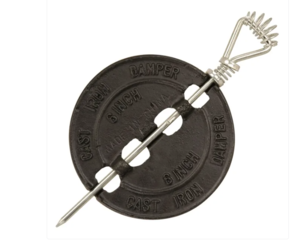
Last edited:
jzinckgra
Feeling the Heat
I have access to a digital manometer. I assume I can pull my flu thermometer and stick the probe in that hole?
EbS-P
Minister of Fire
These are for single wall pipe. You need a double wall damper.Couldn't I just buy the damper and drill the holes in my existing pipe? I think I'll play around more with my approach before considering a damper. Based on other reports, unless my fire is hard to control even with primary fully closed, it does not seem adding a damper makes sense.
View attachment 319762
I wish this was true of all brands, but it's not. DuraVent DVL puts the damper section in the starter collar which would be ok, but this adapter does not fit many modern stoves well. A regular key damper for single-wall often doesn't have the added shank length on the handle side so I ended up having to take the damper section out of the adapter and then install it into a 6" section of DVL.Find the brand of double wall you have and they should sell a short section you can add that contains the damper. Usually the slip connection can take up the extra length (if you have one).
That looks like a very loosely fed fire with the logs criss-crossed. This stove can be loaded N/S. For a long and slow burn, load it N/S with little air space between the thick splits. Top light with kindling.I've been burning our F55 for nearly 10yrs and somewhat embarrassingly, I still can't seem to get it to run consistent. Similar to others here, I have a hard time getting stove top up to 400-500F on ititial light. Typically, I'll get the initial fire up to 350F then start to close her down. The flue temp at that point is usually ~1000F. If I were to target a stopetop temp of 500-600, my flu temp would probably be over 1200F. Is that safe? I also notice that more often then not, my flu temp is more than 100F higher than stovetop regardless if it's the initial burn or a reload. Just this morning I threw in 3 pieces on a small bed of coals and once I got it going the stovetop temp was 350F, but flu temp was 600F. Air lever about 1/3 open. If I close it up, fire would die. We have double wall pipe (8') on the inside with a slight jog around the ceiling joist before exiting. Outside stack is 18'. Seems like we almost have too much draft, but not sure. We usually burn mostly oak with a little bit of pine, maple and ash. At times I really like the stove and it seems to behave well, but a lot of time is frustrating trying to get it to not lose the flame or get any secondary combustion. I understand there are a lot of variables, but would like to getter better performance. I'm sure it's the user, lol
View attachment 319761
Our stove has a similar sized firebox, it's on a 20' straight-up flue. This is how she runs.
Starting a fire and running an EPA stove
Questions about starting a fire and avoiding a runaway stove come up so frequently I decided to document starting our stove. This is a Pacific Energy Alderlea T6 with about a 3 cu ft firebox. The stove is connected to a straight-up, 20' interior flue. The outside ambient temperature is 34ºF. The...
 www.hearth.com
www.hearth.com
jzinckgra
Feeling the Heat
yes, i was just throwing a few pieces in this morning to take the chill off. I am going to check my draft tonight and go from there.That looks like a very loosely fed fire with the logs criss-crossed. This stove can be loaded N/S. For a long and slow burn, load it N/S with little air space between the thick splits. Top light with kindling.
Our stove has a similar sized firebox, it's on a 20' straight-up flue. This is how she runs.
Starting a fire and running an EPA stove
Questions about starting a fire and avoiding a runaway stove come up so frequently I decided to document starting our stove. This is a Pacific Energy Alderlea T6 with about a 3 cu ft firebox. The stove is connected to a straight-up, 20' interior flue. The outside ambient temperature is 34ºF. The...www.hearth.com
This is a good way to cause the splits to ignite quickly which is ok for getting a coal bed established quickly, but it's also a good way to burn up wood fast, especially if it's nice and dry.yes, i was just throwing a few pieces in this morning to take the chill off. I am going to check my draft tonight and go from there.
Similar threads
- Replies
- 14
- Views
- 589
- Replies
- 47
- Views
- 3K

